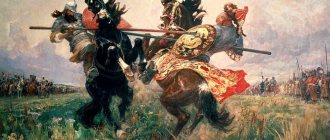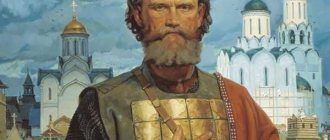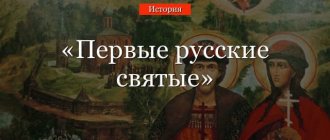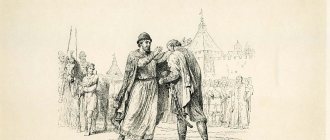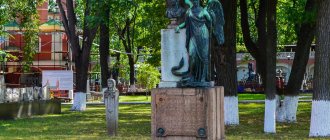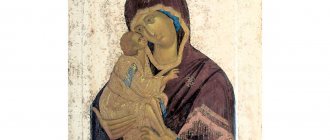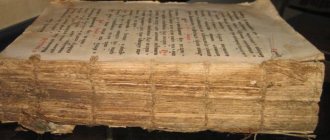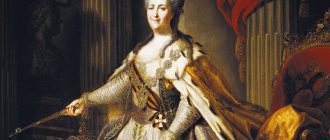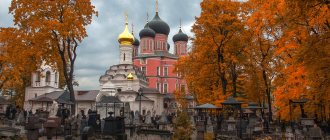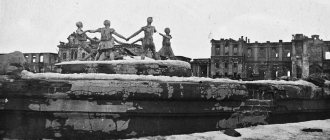Prince Dmitry Donskoy, whose policy marked the beginning of the liberation of the Russian land from the yoke of the Mongol-Tatars, did a lot to unite the scattered Russian principalities around Moscow. Being a wise ruler and diplomat, the prince laid the foundation for the construction of the Russian state.
Prince of Moscow
Prince Dmitry Ivanovich Donskoy (1350–1389), after the death of his father, began reigning in Moscow at the age of nine. At this time, feudal strife began in the Horde, and it began to weaken. But Mamai’s power still extended to Rus'. In addition, Lithuania created an alliance with the Horde, directed against Rus' and its principalities, and occupied Tver. Moscow at this time rebuilt a new white-stone fortress. The economic struggle with the Horde continued, and thanks to the efforts of Moscow, the tribute was reduced, and a dynastic marriage was concluded between the Serpukhov prince Vladimir and the daughter of the Lithuanian prince Olgerd. What is Dmitry Donskoy famous for? Diplomatic skills, first of all.
Personal life
According to the chronicles, the marriage of Dmitry Donskoy with Evdokia Dmitrievna was extremely happy. At the time of the wedding, the groom was barely 16 years old, and the bride was only 13 years old.
Evdokia Dmitrievna, wife of Dmitry I Ivanovich
In this family union they had 9 boys and 3 girls. After Dmitry's death, his 2nd son Vasily 1 took the throne, since the prince's first-born died in childhood.
Dmitry and Evdokia often helped poor people and built churches. An interesting fact is that in 1988 the Orthodox Church canonized Donskoy. In turn, Evdokia was also noted by the church. After the death of her husband, she took monastic vows and began to be called Euphrosyne. Today she is considered the patroness of Moscow.
Legendary figure
Prince Dmitry Donskoy is an iconic figure. He has long become a symbol of the great commander. Dmitry Donskoy, who came from the depths of time, is overgrown with myths, but this is the case when myth and reality coincide. He truly lives up to the concept of a great commander.
Dmitry Donskoy, as the years of his reign showed, was truly an outstanding, unusual figure of his time. He was a man who had enormous self-confidence in his special mission. Not in himself personally, not in self-confidence, but that from above the Lord gave him a special task, a special goal among people. Dmitry Donskoy felt like God's chosen one. The Lord set before him the task of liberating Rus', and he must do this at any cost. When Dmitry rebelled against the Golden Horde, he felt it as a mission that was given to him from above.
Fight for the throne
From a young age, Dmitry Ivanovich was forced to fight for his place in the sun - or more precisely, for the city of Vladimir, which was also claimed by other rulers. In particular, Mikhail Tverskoy made life very difficult for the young prince, who provoked a war between Moscow and Lithuania, which was then ruled by the great Olgerd - a very brave man and a talented commander.
However, in the 70s, Olgerd of Lithuania was unable to cope with Moscow, although he caused a lot of trouble - the principality of young Dmitry was greatly ruined, and his subjects were captured.
Important! The Moscow prince married when he was 14 years old. According to legend, they met their bride Evdokia when they were very young and fell in love at first sight. From this marriage 12 children were born. The eldest son died in infancy, and the second son Vasily became the heir to the Moscow princely throne.
Rice. 2. Dmitry Donskoy. Portrait from the Tsar's title book. 1672
Suspicious adventure
But for those around him it looked a little different. Many believed that the uprising against the Golden Horde was an adventure, that Dmitry Ivanovich Donskoy, at his own peril and risk, raised this uprising, and now a huge black cloud is walking across the steppe - these are the warriors of Mamai. And now let him deal with them himself. He started this mess, let him sort it out. That was the attitude. And therefore, in the summer of 1380, when Dmitry learned from his intelligence that the Tatars had gone on a campaign and that they had a huge army, Dmitry Donskoy sent messengers to all his Russian princes, who all once gathered with him and said that they needed to raise insurrection.
And so he sends messengers to them and writes: come, the very hour has come when we must rise together to this holy war. And suddenly he begins to receive strange answers. One writes that he cannot, his horses are sick, the horses are completely hungry, the other has left somewhere at this time, and it is impossible to find him. The third has some other reasons. The Russian commander found himself almost alone. The Nizhny Novgorod prince, his father-in-law, Dmitry Konstantinovich, did not come, the Tver prince, Mikhail Alexandrovich, did not come, the Novgorodians did not come. Only a few princes came: Belozersky, Rostov - small in number of squads. And in this situation, Dmitry understands that only one thing can save him - the people’s militia.
Relations between Dmitry Donskoy and the Golden Horde
When Dmitry was summoned to the khan in Sarai in 1371, he became convinced that the Tatar-Mongols were no longer able to defend their power. He did not hesitate to fight Ryazan, although it was supported by the Tatar-Mongol army, and when he was given the orders of the khan, Dmitry ignored them. In 1376 he sent a large army to Kazan on the Volga and forced two Tatar leaders to pay tribute. The growing internecine conflicts in Lithuania, caused by the death of Olgerd in 1377, also benefited Moscow. Moscow began to reduce tribute and finally stopped paying it altogether. The Tatar-Mongols could not come to terms with the fact that the Moscow prince actually declared independence from the Horde. Mamai tried to punish Dmitry by sending an army in 1378, but was defeated by Dmitry's forces in the Battle of the Vozha River near Ryazan, which caused Dmitry to exclaim: "Their time has come, and God is with us!" A year later, the Khan sent an army to ravage Ryazan and began preparations to restore power over Moscow. Urgently in need of funds to stop Tokhtamysh, who had made himself Khan of Sarai, and wanting to avenge the defeat at Vozha, Mamai launched a massive military campaign against Russia in the late summer of 1380.
As soon as Dmitry learned of his enemy's plans, he went to the Holy Trinity Monastery near Moscow to receive advice from the abbot of the Russian land, Saint Sergius of Radonezh (c. 1314-1392), an astute politician known for his fervent prayers for the Russian land. He gave his blessing to Prince Dmitry’s life-and-death struggle with the enemy:
“You should, sir, take care of the glorious Christian flock entrusted to you by God. Go against the godless, and if God helps you, you will win and return unharmed to your fatherland with great honor.”
Saint Sergius spoke about the upcoming victory as if it were obvious to everyone. He allowed two monks Alexander-Peresvet and Andrei-Oslyaba, known for their bravery, to join Dmitry Ivanovich’s army in order to set an example. Having drawn crosses on their schemas, he said:
“Here is a weapon that never disappears!”
Militia gathering
We need to convince ordinary people to go to war - townspeople, peasants, who in fact have never fought, it’s not their business. Professionals and combatants fought. People's militia were collected extremely rarely. In some emergency cases, when the question was not just about a war between Prince, say, Ivan, and Prince Konstantin, but the question was about the fate of our faith, about Orthodoxy, that is, this war with Mamai had to be staged as a holy war, a war for faith. To do this, Dmitry needed to receive a blessing from some figure. So that a person who is trusted by the people, whom he considers truly holy, would bless the war with Mamai and raise it to the height of a holy war, a war for faith.
Sergius of Radonezh
At that time, in North-Eastern Rus' there lived only one person whom people unconditionally trusted, whom people considered a living saint, because his life was such that he lived impeccably. It was St. Sergius of Radonezh. St. Sergius of Radonezh, founder of the monastery 70 km northeast of Moscow, is the abbot of this monastery. This is, of course, a great man for our church. But, in addition, St. Sergius embodied the Christian ideal of monasticism in his daily life: a monk is an absolutely gentle, selfless person, ready to provide some kind of help to everyone, to support everyone, to give good advice to everyone. And the fame of St. Sergius spread very widely. But, of course, Sergius did not interfere in politics. And now Dmitry had the last chance to turn to St. Sergius. The Monk Sergius did not like the war with the Horde, because the risk was very great.
Dmitry Ivanovich Donskoy (10/12/1350 - 05/19/1389) - Grand Duke of Moscow and Vladimir, winner of Mamai in the Battle of Kulikovo on the field at the confluence of the river. Nepryadva in the Don River on September 8, 1380, for which he received the nickname Donskoy.
Born on October 12, 1350 in Moscow, belonged to the 15th tribe of Rurikovich, great-great-grandson of Alexander Nevsky, grandson of Ivan Kalita, became a prince at the age of 9 after the death of his father Ivan the Red. The de facto supreme ruler of the Moscow principality under the young Dmitry became Metropolitan Alexy - a man of remarkable intelligence, possessed of a strong character, skillfully using his authority to implement the idea of Moscow's supremacy in North-Eastern Rus'. Dmitry consulted with him, continuing the policy of his father and grandfather of collecting Russian lands around Moscow.
By the middle of the 14th century, North-Eastern Rus' consisted of separate strong principalities: Moscow, Tver, Suzdal. The oldest prince was considered the one who bore the title of Grand Duke of Vladimir, the label for the great reign of which was issued in the Horde.
Dmitry had to wage a long struggle with the rival princes (Suzdal-Nizhny Novgorod, Ryazan and Tver) for the great reign.
After a long confrontation, Dmitry Ivanovich received the right to be considered the Grand Duke alone; in 1365, he consolidated relations with Suzdal by marrying the Suzdal princess Evdokia Dmitrievna. Sergius of Radonezh recommended that Dmitry choose the daughter of the Suzdal prince Evdokia as his wife. Suzdal was not dangerous to Moscow, but it was an advantageous strengthening of the Moscow principality from the Nizhny Novgorod side. Over 22 years of marriage, the pious family had 8 sons (two died at an early age) and 4 daughters.
After enmity with the Lithuanian prince Olgerd, peace was concluded with Lithuania. Gradually, Donskoy established relations with Novgorod and Tver. The power of Prince Donskoy grew more and more over time.
In the summer of 1380, frightened by the strengthening of the Moscow principality, the actual ruler of the Golden Horde, Mamai, moved to Rus'. Squads from many Russian lands converged in Kolomna, where Dmitry Ivanovich’s headquarters was located. There were probably 100-120 thousand warriors on both sides. On September 8, 1380, on the Kulikovo field, in the place where the Nepryadva River flows into the Don, Russian and Horde troops converged for a decisive battle. According to legend, the Russian soldiers for this battle were blessed by St. Sergius of Radonezh, the founder and abbot of the Trinity-Sergius Monastery. Later legends say that he sent two of his knights to Dmitry Ivanovich - the monks, Oslyabya and Peresvet. The battle began with a duel between Peresvet and the Tatar hero Chelubey. The warriors, at full gallop, struck each other with their spears and both fell from their horses dead. Immediately after this fight, a fierce battle began, ending with Mamai’s flight from the battlefield and the complete defeat of the Tatar-Mongol army.
Dmitry Ivanovich was found seriously wounded on the battlefield. Jagiello, who was going to join Mamai, learned about the defeat of the Horde and turned back (according to other sources, he camped 20 miles from the Kulikovo field and never entered the battle). Oleg Ivanovich Ryazansky fled to Lithuania, but soon returned and concluded a peace treaty with Dmitry. For his victory on the Kulikovo field, Dmitry Ivanovich was nicknamed “Donskoy”.
Dmitry Donskoy’s main service to his descendants is his victory on the Kulikovo Field. The Battle of Kulikovo was of historical significance in the struggle of the Russian and other peoples for liberation from the yoke of the Golden Horde. Although it did not lead to the elimination of the Mongol-Tatar yoke in Rus', however, on the Kulikovo Field a severe blow was dealt to the dominance of the Golden Horde, which accelerated its subsequent collapse.
The strategy and tactics of the battle are worthy of study by descendants; the Russians won not by numbers, but by skill, primarily by the skill of their commanders.
In 1367, after a big fire in Moscow, by order of Dmitry, the construction of a new Kremlin began - white stone, which made it possible to reliably protect Moscow from enemy raids. Also, during the reign of Dmitry Donskoy, fortress monasteries were erected - Simonov and Andronikov, covering the approaches to the city center.
During the first 20 years of his reign, Dmitry managed to become a recognized collector of Russian lands, the territory of the Moscow principality expanded under him to include the territories of Pereyaslavl, Galich, Beloozero, Uglich, Dmitrov, part of Meshchera, as well as Kostroma, Chukhloma, Starodub and northern Komi-Zyrian (where The Perm bishopric was founded) lands. Maintaining friendly ties with Orthodox Byzantium, Dmitry sought recognition of the independence of the Russian Orthodox Church from Constantinople.
Dmitry Donskoy also did a lot for the development of the Moscow principality - he populated empty lands with new people, building entire villages for them at state expense, and created artels of artisans.
Under Dmitry Donskoy, there was a change in the succession of power; for the first time it passed not to the eldest in the family, for example, the brother of the deceased, but to the son of the ruler. This provision was disputed more than once, but in principle remained unchanged, stopping the bloody struggle for power between relatives.
Dmitry Ivanovich Donskoy died on May 19, 1389 at the age of 39. He was buried in Moscow in the Archangel Cathedral of the Kremlin. After the death of Donskoy, control of the principalities was inherited by his son Vasily I.
Dmitry Donskoy was canonized by the Russian Orthodox Church in 1988. Memorial Day is celebrated on the day of his death - May 19 (June 1, new style).
The name of Dmitry Donskoy has become a symbol of Russian military glory over several centuries. During the Great Patriotic War, a tank column was named in honor of Dmitry Donskoy. In 2002, the Order “For Service to the Fatherland” was established in memory of the Holy Grand Duke Dmitry Donskoy and the Venerable Abbot Sergius of Radonezh. In the Russian Navy, sailing battleships, a screw frigate, an ocean-going armored cruiser and a nuclear submarine were named after the prince at various times.
Take a bow
But when the Russian commander came to him at the Trinity Monastery on August 16, 1380 and said: “Holy Father, bless,” Sergius rose above personal relationships, above vain considerations, and gave him not just his blessing, but also his two monks, Peresvet and Oslyabyu.
Why did he give his monks? It would seem a strange decision. Why does he send monks to fight? This was generally a violation of monastic rules, because a monk must sit in a monastery. A warrior must fight, and a monk must pray, each has his own job. And then suddenly St. Sergius sends two monks to battle. The fact is that they were visible evidence that this was the blessing of St. Sergius. After all, the world was small then. People knew each other by sight, just like in the village. And everyone knew that Peresvet and Oslyabya in the past were respected Moscow governors, noble people, but then they went to a monastery. And everyone understood that if they were traveling next to Dmitry, then the campaign was blessed by the monk.
Refusal to pay tribute and the Battle of the Piana River
After a dynastic crisis arose in the Golden Horde in the 1360s, the khans began to challenge each other for power, Moscow realized that the time had come to take an important step. And starting from 1377, Moscow and some other lands refused to pay tribute to the horde. However, the punishment followed almost immediately. In the same year, 1377, a battle took place on the Piana River, in which the Tatar-Mongols managed to take the Russian army by surprise and kill many soldiers.
The battle on the Piana River forced Muscovites to be more cautious, especially since the dynastic crisis in the horde finally seemed to have ended, and the Temnik Mamai came to power. Already in the next 1378, Mamai sent an army to Rus' led by Murza Begeche, but this army was defeated by the Muscovites in the battle on the Vozha River. It is believed that it was the battle on the Vozha River that became the prologue to the Battle of Kulikovo.
The balance of power - the thoughts of the prince
He did not wait for the Tatars to besiege Moscow, although he already had a decent stone fortress, and some advised him to sit out in it. And so Dmitry led the troops to the Kulikovo field. The people's militia went with him.
And then he acts like an excellent commander who accurately calculates everything. He went to meet the enemy, into the steppe. This was an unusual military technique. But it was the right decision.
Decisive battle
Then he came to the Kulikovo Field area and ordered his troops to cross the Don. At first glance, they were in a completely unfavorable position. On one side is the Don, on the other side in a deep ravine is the Nepryadva River. That is, there is nowhere to run. If the army falters and runs, it will disappear when crossing the river. The Tatars will kill them all. But it was right at that moment. Each warrior had to be given this thought: either win or die. There will be no salvation in flight. We need to fight. It was a bet to win. This is how Dmitry Donskoy’s Battle of Kulikovo was thought out.
Night thoughts
On the night of September 7-8, 1380, Dmitry realized one very important thing: when the battle began, the large regiment of thousands of militia he brought might not be able to withstand it. And Dmitry imagined what a Horde attack was like: the black Horde cavalry rushes with whoops, screams, squeals, and howls. She rushes towards a large regiment, where there are untrained militiamen. And at the sight of this avalanche, their nerves will not stand, they will run. It will be an irrational fear that will take over everyone. How to save the militias? How to take the first blow? And Dmitry makes the only right decision. He places in front a well-trained guard regiment, which consisted of selected warriors, clad in iron. Those people who could hold back this avalanche for about an hour. And Dmitry himself goes to this advanced regiment. It was clear that this regiment was doomed to destruction. This is how Dmitry Donskoy thought of the Battle of Kulikovo. But these warriors will stop the cavalry avalanche for some time, and during this time the militia will have time to come to their senses and have time to overcome their fear. And so it happened.
The first years of the reign of Dmitry Donskoy
An important event in the first years of Dmitry's reign was the construction of the first stone Moscow Kremlin, completed in 1367. The new fortress allowed the city to withstand two sieges of Olgerd in 1368 and 1370. A third siege attempt in 1372 ended with the Treaty of Lubut, signed in the summer of 1372 between Olgierds (Algirdas), the Grand Duke of Lithuania and Dmitry, which led to a seven-year peace.
The only principality that Dmitry did not subjugate was Tver. The conflict was caused by the fact that in 1366 Mikhail Konstantinovich took the throne of the Tver principality with the help of his son-in-law Olgerd. The hostilities lasted eight years (1368-1375): Mikhail unsuccessfully attempted to capture Moscow in 1368, and Dmitry captured the city of Mikulin in 1370. Dmitry defeated Mikhail four times. Four times Mikhail, helped by Olgerd, won. Finally Olgerd died, and in 1375 Michael relented, recognizing himself as Dmitry's vassal. Other princes of Northern Russia also accepted Dmitry's seniority.
On the Kulikovo Field
The next morning, Dmitry arranged the shelves. He himself went to the guard regiment on the front line. An avalanche of Tatar cavalry from the top of the Red Hill attacked the Russian army. The entire regiment in front was destroyed.
But while the Horde fought with him, maybe half an hour, maybe an hour passed, and the militia came to their senses. They saw that it was possible to stop the Tatars. That the energy of the avalanche is no longer the same, it has already been stopped. And therefore, when the Tatars reached the large regiment, it stood to the death and did not run anywhere.
Ambush
And, of course, there was an excellent decision - to place an ambush regiment in the oak grove under the command of Vladimir Andreevich Serpukhovsky. And this ambush regiment, unexpectedly striking the flank of the Tatar cavalry that was not expecting anything, already in the middle of the battle decided the outcome of the battle.
The Tatars wavered and began to retreat. As soon as this happened, Dmitry threw up reserves on this flank, and the counter-offensive began. That is, everything was thought out. Right down to his own role. This is how the battle of Dmitry Donskoy took place. After all, at that time rulers usually stood in the rear. And Dmitry rode forward, past the regiments, so that everyone could see that he was going to fight in the front ranks, that he was ready to give his own life for victory, that he would not abandon them, would not run away. What is Dmitry Donskoy famous for? A feat of self-sacrifice.
early years
In 1359, Metropolitan Alexy, who had great authority, became the guardian of 9-year-old Dmitry and the de facto ruler of the Moscow principality. Ivan the Red bequeathed to his two sons the estates left to him by Ivan Kalita. After the death of his younger brother, these lands were united under the rule of Dmitry.
In 1362, the temnik Mamai, who actually ruled the Horde on behalf of Khan Abdullah, issued a label to Dmitry Ivanovich, and the Moscow army expelled the Suzdal prince Dmitry Konstantinovich from Pereyaslavl and Vladimir.
Definition 2
The label is the credentials of the Mongol khans to the Russian princes for the great reign in the 13th-15th centuries.
Finished works on a similar topic
Coursework Dmitry Donskoy and his role in the history of Russia 410 ₽ Essay Dmitry Donskoy and his role in the history of Russia 240 ₽ Test paper Dmitry Donskoy and his role in the history of Russia 250 ₽
Receive completed work or specialist advice on your educational project Find out the cost
Hard won
After the battle it took a long time to find him. He was seriously wounded. Vladimir Andreevich Serpukhovskoy sent soldiers to look for him. Severely wounded in this battle, Dmitry barely survived.
They found him and brought him to consciousness, he mounted his horse and together with his brother they went to inspect the battlefield. We saw that the field was littered with corpses. The victory came at a heavy price. Moscow's military potential was undermined.
After the battle, the prince's army arrived first in Kolomna and then in Moscow. Now there is a monument to Dmitry Donskoy on the Kremlin tower in Kolomna.
Dmitry Donskoy returns the label and retains power
The offended Khan Murut took the label from Dmitry Ivanovich and handed it to Dmitry Konstantinovich. But Metropolitan Alexy was faithful to the children of Ivan II and turned to the khan on behalf of his young ward. Murut received him favorably, and in 1363 the Muscovites quickly moved to Vladimir, deposing Dmitry Konstantinovich before plundering the Suzdal lands. During this campaign, Dmitry took Starodub and Galich, annexing these principalities to his possessions, and possibly Belozero and Uglich. By 1364, he forced Dmitry Konstantinovich to capitulate and sign an agreement recognizing Moscow's sovereignty over Vladimir. The agreement was sealed with signatures in 1366, and in the same year he married the daughter of Dmitry Konstantinovich Evdokia. The couple had at least 12 children.
To maintain his influence, Dmitry Ivanovich sends Prince Konstantin Vasilyevich from Rostov to Ustyug in the north and replaces him with his nephew Andrei Fedorovich, who supports Moscow. As a precedent, Dmitry gave his cousin, Prince Vladimir Andreevich Serpukhovsky, independent sovereignty over Galich and Dmitrov, thereby establishing the de facto right of the Moscow princes to preserve hereditary lands and dispose of the conquered territory.
The meaning of the battle
The historical significance of the Battle of Kulikovo is that it finally determined the role of Moscow as the center of the unification of Rus'. Moscow proved on the Kulikovo Field that it can liberate the country. She can achieve independence. We need to help her, we need to support her. What is Dmitry Donskoy famous for? He showed, not in words, but in deeds, that he was ready to fight for freedom. Therefore, Vasily Osipovich Klyuchevsky formulated this well, saying that the Moscow state was born in the vastness of the Kulikovo Field. This is a metaphor, but it gets the point across exactly. And the majestic monument to Dmitry Donskoy reflects his great deed to his descendants.
The last years of Dmitry Donskoy's life were difficult. He felt pressure from all sides. Lithuania grew stronger, the Horde demanded more tribute. And perhaps these adversities shortened his life. He died at the age of 38 in May 1389.
This is such a relatively short and heroic life. This man, Grand Duke Dmitry Donskoy, rightfully occupies a prominent place in our history. He deserves it.
Khan Tokhtamysh besieges Moscow
The successes achieved in the battle, at first glance, contributed to the fall of Tatar-Mongol power over Moscow, but it soon became clear that this was not the case. Tokhtamysh took the opportunity to overthrow Mamai in 1381, becoming the last khan of the White Horde. He united the White Horde and the Blue Horde into a single state - the Golden Horde and confirmed his title as ruler of the Russian lands. In 1382, Tokhtamysh's army besieged Moscow, and Dmitry went to Kostroma to gather an army. Meanwhile, Moscow was captured by deception and put to fire and sword. It is said that 24 thousand inhabitants were killed. Vladimir and other cities suffered the same fate. They say that Dmitry cried when he saw the charred remains of his capital. However, there was nothing left but to make peace with Tokhtamysh. Dmitry swore allegiance to the Khan and became Grand Duke of Vladimir again, agreeing to pay a much higher tribute to Tokhtamysh for the label on Vladimir than he had originally paid to Mamai.
But his soul was restless: the princes of Tver and Ryazan incited Novgorod and Mamaia to use the plight of Moscow to plunder other cities of the Moscow principality. After the country had sufficiently recovered, he forced the Prince of Ryazan to conclude an "eternal peace", and Novgorod in 1386 was forced to pay reparation in addition to agreeing to an annual tribute.
